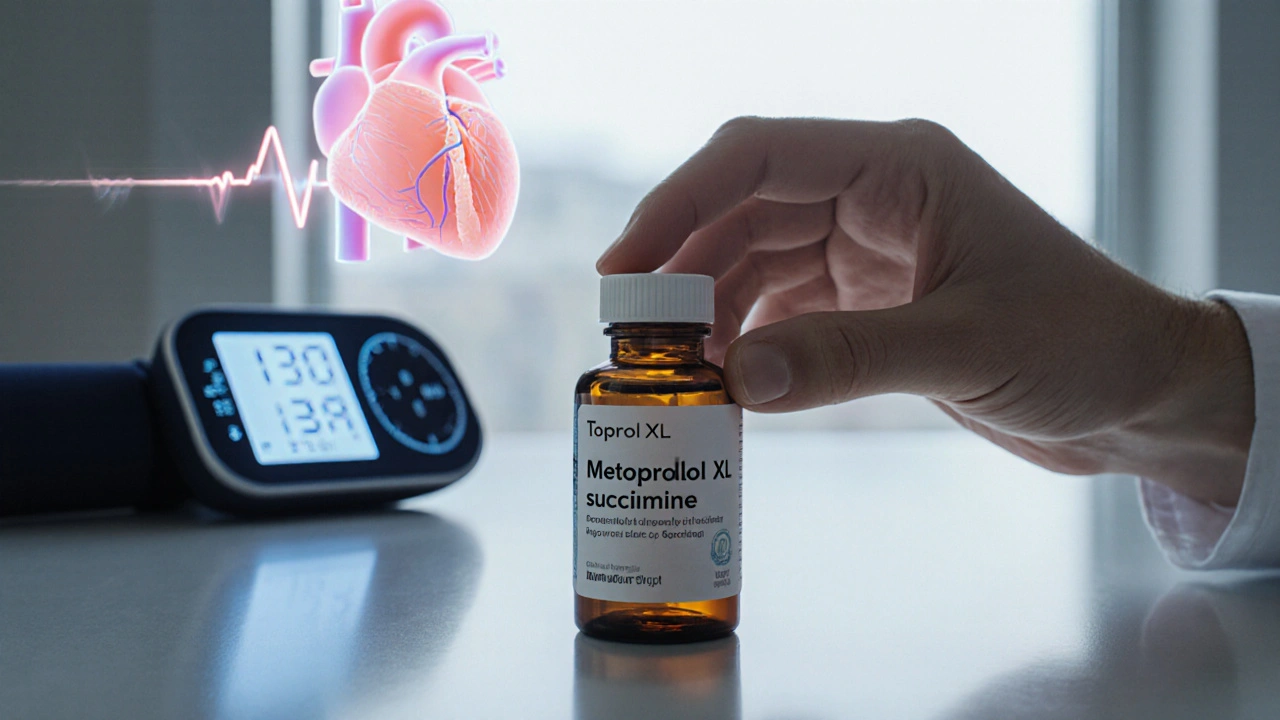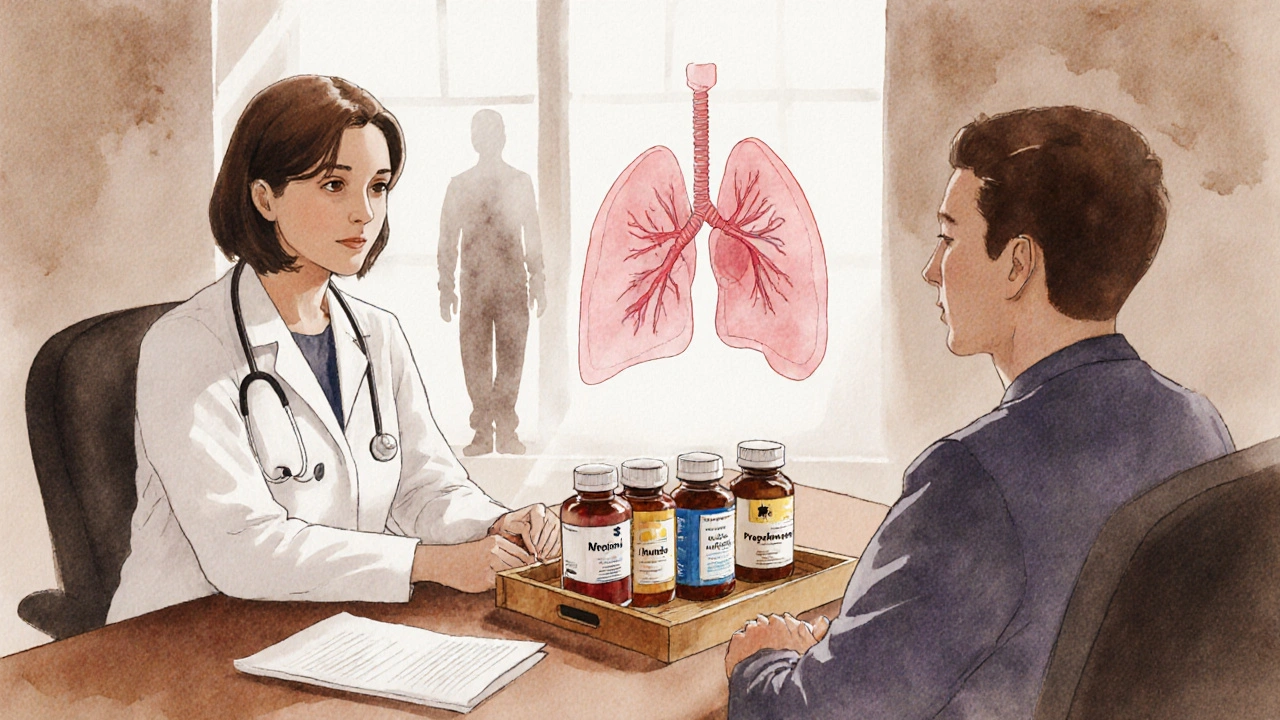
Beta Blocker Selector Tool
Recommended Beta Blocker
Select your conditions and preferences, then click "Find Best Match"
Quick Takeaways
- Toprol XL is a long‑acting beta‑1 selective blocker ideal for hypertension, angina, and heart‑failure management.
- Alternative beta blockers differ mainly in selectivity, half‑life, and side‑effect profiles.
- If you need extra heart‑rate control for atrial fibrillation, carvedilol or propranolol may be better choices.
- Patients with asthma or severe COPD should consider more cardio‑selective options like atenolol or bisoprolol.
- Cost and insurance coverage vary widely; generic metoprolol is usually the cheapest option.
When doctors prescribe a beta blocker, they often start with Toprol XL is a long‑acting, cardio‑selective beta‑1 blocker (generic name metoprolol succinate) used to treat high blood pressure, angina, and chronic heart failure. It’s taken once daily, which helps patients stick to the regimen.
But there are plenty of other drugs that work in a similar way. If you’re wondering whether Toprol XL is the right fit or if another pill might match your needs better, this guide walks you through the most common alternatives, how they compare on efficacy, safety, dosing, and price, and which patient profiles they suit best.
Why Compare Beta Blockers?
Beta blockers share a core mechanism: they block the effects of adrenaline on beta‑adrenergic receptors. However, they differ in receptor selectivity (beta‑1 vs. beta‑2), intrinsic activity, duration of action, and how the body processes them. Those differences translate into real‑world outcomes-some patients feel a wave of fatigue, others get a dry cough, and a few experience worsening breathing problems.
Choosing the right blocker means matching the drug’s pharmacology to the patient’s medical history, lifestyle, and even insurance plan.
Key Attributes to Evaluate
- Receptor selectivity: Cardio‑selective (beta‑1) agents spare the lungs, which is crucial for asthmatics.
- Half‑life and dosing frequency: Longer half‑lives allow once‑daily dosing.
- Metabolic pathway: CYP2D6 metabolism can cause drug interactions.
- Side‑effect profile: Fatigue, cold extremities, sexual dysfunction, or bronchospasm.
- Clinical indications: Hypertension, angina, heart failure, post‑myocardial‑infarction, atrial fibrillation, migraine prophylaxis.
- Cost and availability: Generic vs. brand name pricing.
Major Alternatives Overview
Below are the most frequently considered substitutes for Toprol XL, each introduced with microdata so search engines can recognize them as distinct entities.
Atenolol is a cardio‑selective beta‑1 blocker with a shorter half‑life, typically taken twice daily. It’s often used for hypertension and angina but is less potent in heart‑failure settings.
Carvedilol is a non‑selective beta blocker that also blocks alpha‑1 receptors, providing vasodilation. Its dual action makes it valuable for heart‑failure patients who need both heart‑rate control and afterload reduction.
Propranolol is a non‑selective beta blocker with high lipid solubility, crossing the blood‑brain barrier. It’s a go‑to for migraine prevention and tremor control, but its beta‑2 blockade can trigger bronchospasm.
Bisoprolol is another cardio‑selective beta‑1 blocker with once‑daily dosing, similar in selectivity to metoprolol but with a slightly longer half‑life. It’s approved for heart‑failure and chronic obstructive pulmonary disease‑friendly patients.
Lisinopril is an ACE inhibitor, not a beta blocker, used as an alternative pathway for blood‑pressure control. While not a direct beta‑blocker alternative, many physicians switch to it when beta‑blockers cause intolerable side effects.

Side‑Effect Spotlight: What to Watch For
Every medication carries a risk. Below is a quick side‑effect matrix to help you anticipate issues.
| Drug | Fatigue | Cold extremities | Bronchospasm risk | Sexual dysfunction |
|---|---|---|---|---|
| Toprol XL (Metoprolol) | Moderate | Common | Low (beta‑1 selective) | Occasional |
| Atenolol | Low‑moderate | Common | Low | Occasional |
| Carvedilol | High | Very common | Moderate (non‑selective) | Frequent |
| Propranolol | High | Common | High | Frequent |
| Bisoprolol | Low‑moderate | Common | Low | Rare |
Dosage & Administration Cheat Sheet
- Toprol XL (Metoprolol): Start 25-100mg once daily; typical maintenance 100-200mg daily. Adjust for renal impairment.
- Atenolol: 50mg once or twice daily; max 200mg per day. Shorter half‑life may need twice‑daily dosing.
- Carvedilol: Initiate 3.125mg twice daily; target 25mg twice daily for heart failure. Titrate slowly because of hypotension risk.
- Propranolol: 40mg twice daily for hypertension; up to 240mg daily for migraine prophylaxis.
- Bisoprolol: 2.5mg once daily, increase to 10mg as tolerated.
- Lisinopril: 10mg once daily, max 40mg.
Cost Comparison (2025 US Prices)
Prices fluctuate with insurance contracts, but the following averages give a sense of out‑of‑pocket expense for a 30‑day supply.
| Drug | Brand (if applicable) | Generic price | Typical insurance copay |
|---|---|---|---|
| Toprol XL (Metoprolol) | $45 | $12 | $5‑$10 |
| Atenolol | - | $8 | $4‑$9 |
| Carvedilol | $38 | $15 | $6‑$12 |
| Propranolol | - | $10 | $5‑$11 |
| Bisoprolol | - | $13 | $5‑$10 |
| Lisinopril | - | $7 | $3‑$8 |
Choosing the Right Agent: Decision Flow
Use the following quick‑check guide to narrow down the optimal medication.
- If you have asthma or COPD, stick with a highly cardio‑selective blocker (Toprol XL, atenolol, bisoprolol).
- For heart‑failure with reduced ejection fraction, carvedilol or bisoprolol have the strongest evidence base.
- When you need migraine prophylaxis or control of essential tremor, propranolol’s non‑selectivity is an advantage.
- If you experience persistent fatigue on metoprolol, consider switching to atenolol (shorter half‑life) or bisoprolol (lower central nervous system penetration).
- When cost is the primary concern, generic metoprolol remains the cheapest cardio‑selective option.
- If blood‑pressure control fails despite maximal beta‑blockade, adding or swapping to an ACE inhibitor like lisinopril can provide complementary vasodilation.

Potential Drug Interactions
Because most beta blockers are metabolized by the CYP2D6 enzyme, co‑administration with strong inhibitors (e.g., fluoxetine, paroxetine) can raise plasma levels and increase the risk of bradycardia. Below is a short interaction list:
- Metoprolol + SSRI antidepressants: Monitor heart rate; dose reduction may be needed.
- Carvedilol + potassium‑sparing diuretics: Watch for hyperkalemia, especially in kidney disease.
- Propranolol + asthma inhalers: Increased bronchospasm risk; consider cardio‑selective alternatives.
- Atenolol + digoxin: Both lower heart rate; check for excessive bradycardia.
What the Guidelines Say (2024-2025)
Major cardiology societies still list beta blockers as first‑line therapy for heart‑failure with reduced ejection fraction (HFrEF) and post‑myocardial‑infarction care. The ACC/AHA 2024 guideline grades metoprolol succinate (Toprol XL) and carvedilol as Class I, Level A recommendations for HFrEF. For pure hypertension without comorbidities, newer agents like ACE inhibitors or calcium‑channel blockers are often preferred, but beta blockers remain a solid choice when patients also need rate control for atrial fibrillation.
Real‑World Patient Stories (Illustrative)
John, 58, with type‑2 diabetes and mild COPD, started on Toprol XL for hypertension. After a month he reported cold hands and occasional shortness of breath during gardening. His cardiologist switched him to bisoprolol, noting the similar cardio‑selectivity but lower impact on peripheral circulation. John’s blood pressure stayed controlled, and his breathing improved.
Sara, 42, suffers from frequent migraines. Her primary care physician tried propranolol, which lowered her migraine frequency but caused vivid dreams and fatigue. Switching to low‑dose atenolol reduced the side effects while still providing migraine relief.
Bottom Line: How to Decide
There’s no one‑size‑fits‑all answer. The best approach is to line up the drug’s qualities against your personal health profile:
- Need strong heart‑failure evidence? Carvedilol or bisoprolol.
- Asthma or COPD? Stick with metoprolol or atenolol.
- Looking for cheap, once‑daily dosing? Toprol XL generic wins.
- Want migraine prevention? Propranolol shines.
Always discuss any switch with your prescriber, especially because tapering off beta blockers abruptly can trigger rebound hypertension.
Frequently Asked Questions
Can I take Toprol XL and an ACE inhibitor together?
Yes. Combining a beta blocker like metoprolol with an ACE inhibitor such as lisinopril is common for patients who need both heart‑rate control and vasodilation. The combo usually improves blood‑pressure control and reduces heart‑failure progression. Your doctor will monitor kidney function and potassium levels.
Why does metoprolol sometimes cause fatigue?
Metoprolol slows the heart and reduces the nervous system’s “fight‑or‑flight” signaling. For some people, that lowered adrenaline tone translates into feeling more tired, especially during the first weeks while the body adjusts. If fatigue persists, dose reduction or switching to a less lipophilic beta blocker may help.
Is it safe to stop Toprol XL abruptly?
Stopping suddenly can cause rebound hypertension, rapid heart‑rate spikes, and even chest pain. Tapering the dose over 1‑2 weeks under a doctor’s guidance is the safest route.
How do I know if I need a cardio‑selective beta blocker?
If you have a history of asthma, chronic bronchitis, or COPD, a cardio‑selective drug (metoprolol, atenolol, bisoprolol) reduces the risk of airway narrowing. Your physician will review lung function tests before deciding.
Which beta blocker is best for migraine prevention?
Propranolol has the strongest evidence for migraine prophylaxis, followed by metoprolol. The choice often depends on tolerance; if you experience fatigue or depressive symptoms, low‑dose atenolol can be an alternative.

Ah, the intricate ballet of beta‑blockers-truly a symphony for the discerning cardiologist. One must appreciate the subtle pharmacokinetic nuances that separate metoprolol succinate from its lesser cousins. The once‑daily regimen of Toprol XL, with its cardio‑selective elegance, often eclipses the twice‑daily hustle of atenolol. Yet, the market’s price‑sensitivity dance can force a compromise, much to the lament of the fiscally‑aware patient. 🍸📈
Great breakdown! If you’re feeling overwhelmed, remember you can start low and titrate up-your body will thank you. 🏃♀️ Keep an eye on fatigue; many folks feel better after the first week. Stay motivated, you’ve got this!
Only the good ol’ American‑made meds truly stand the test of time. 🇺🇸 Our clinicians know that cardio‑selective blockers keep our troops strong and breathing easy. No foreign alternatives needed.
From an evidence‑based standpoint, the beta‑1 selectivity of metoprolol confers a lower bronchoconstrictive risk profile, which is paramount for COPD comorbidity management. The pharmacodynamic half‑life facilitates steady-state plasma concentrations, diminishing the trough‑peak variability observed with atenolol. Moreover, the metabolic pathway via CYP2D6 underscores potential drug‑drug interactions, especially with SSRIs-a nuance often overlooked in primary care. Clinically, the reduction in all‑cause mortality in HFrEF patients on Toprol XL is well‑documented, aligning with ACC/AHA guideline Class I recommendations. In practice, the once‑daily dosing improves adherence metrics significantly.
Love the color‑coded tables-makes the data pop like a fresh canvas! 🎨 The side‑effect matrix is especially handy when counseling a jittery patient. Just remember that “common” doesn’t always mean “unavoidable,” and lifestyle tweaks can tip the scales.
Indeed, the interplay between receptor selectivity and pulmonary safety is a subtle dance of biochemistry and patient quality of life. One could argue that the meta‑analysis on metoprolol’s fatigue profile warrants a nuanced patient‑centred discussion. It’s fascinating how such pharmacologic granularity shapes therapeutic trajectories.
The chart looks polished, but have you considered the hidden costs of “generic” branding? Industry insiders often push these formulas to mask subtle efficacy shifts. Just a thought, you know.
Philosophically speaking, the choice of a beta‑blocker mirrors the existential quest for balance between heart rhythm and breath. When we prioritize cardio‑selectivity, we honour the body’s inherent design. Yet, the allure of non‑selective agents lies in their holistic vasodilatory embrace. The clinician must therefore weigh the ontological weight of each molecule.
yeah i think thats cool.
Super helpful guide! 💡 If you ever feel unsure, remember that a brief chat with your pharmacist can clarify insurance nuances. Keep the conversation open and stay proactive.
This is concise and clear. Good info.
When we embark on the odyssey of cardiovascular pharmacotherapy, we are not merely prescribing pills; we are curating a symphony of molecular interactions that reverberate through the very chambers of the heart. The beta‑1 adrenergic receptor, a gatekeeper of inotropic and chronotropic modulation, offers a nuanced target for those seeking to temper the relentless surge of catecholamines. Toprol XL, with its prolonged release matrix, bathes the myocardium in a steady stream of metoprolol succinate, thereby avoiding the peaks and valleys that plague its immediate‑release cousins. This pharmacokinetic constancy translates clinically into enhanced adherence, a factor that studies have repeatedly linked to reduced morbidity in heart‑failure cohorts. Yet, one must not overlook the heterogeneity of patient phenotypes-some individuals manifest pronounced fatigue, a symptom that may be rooted in central nervous system penetration owing to the drug’s lipophilicity. For these patients, a shift towards more hydrophilic agents such as atenolol or bisoprolol can mitigate central side‑effects while preserving cardiovascular protection. Conversely, the non‑selective agents carvedilol and propranolol, by virtue of their beta‑2 and alpha‑1 antagonism, extend benefits beyond mere heart‑rate control, offering vasodilatory advantages that prove invaluable in certain heart‑failure phenotypes. However, this broader receptor blockade is not without trade‑offs; bronchospasm looms as a specter for asthmatic patients, mandating vigilant pulmonary monitoring. The economic landscape further complicates decision‑making, as generic metoprolol often enjoys the lowest out‑of‑pocket cost, yet insurance formularies may nudge prescribers toward brand‑specific formulations for perceived efficacy. In the realm of evidence‑based medicine, the ACC/AHA guidelines elevate both metoprolol succinate and carvedilol to Class I, Level A status for reduced‑ejection‑fraction heart failure, underscoring the robustness of data supporting their use. Yet, the art of medicine resides in tailoring these guidelines to individual narratives-considering comorbidities, lifestyle, and patient preferences. A collaborative discussion, wherein the clinician elucidates the pharmacodynamic rationale while the patient articulates their experiential concerns, paves the way for shared decision‑making. Ultimately, the goal is not merely to lower a blood pressure reading but to enhance the quality of life, ensuring that each heartbeat is a whisper of stability rather than a clamor of uncertainty. :)
Interesting points, though I’d stress that the meta‑analysis you cite has several methodological flaws. Also, remember that individual response can vary wildly.
My dear colleagues, I must applaud the thoroughness of the above exposition. The integration of guideline‐based recommendations with patient‑centred considerations is most commendable. Let us continue to foster such exemplary discourse.
Sure, because taking a pill is the pinnacle of modern medicine.
Thanks for the clear summary I appreciate the effort you put into this post it really helps a lot
While I respect the comprehensive nature of the analysis, I must assert that the over‑reliance on pharmacologic monotherapy is, frankly, a dangerous oversimplification, especially when lifestyle interventions remain underutilized, and patient autonomy is often sidelined in the zeal to achieve target metrics; we should, therefore, advocate for a more balanced, multimodal approach, integrating dietary modifications, exercise regimens, and psychosocial support alongside judicious medication use, ensuring that we do not reduce complex human beings to mere biochemical equations; this perspective, I believe, is essential for sustainable, patient‑centred care.
Indeed, a holistic view aligns with best practice, and your emphasis on education empowers patients; could we also explore community‑based programs for greater impact? 😊
Have you ever wondered why big pharma pushes these beta‑blockers so hard? It’s a classic case of profit over patient, with hidden clauses in the fine print that keep us locked into costly regimens. Stay vigilant.
Let me clarify: the pharmacodynamics of metoprolol are well‑established, and the data you cite about conspiracies is, frankly, misinformation. I’ve seen the studies – they’re solid. 😑